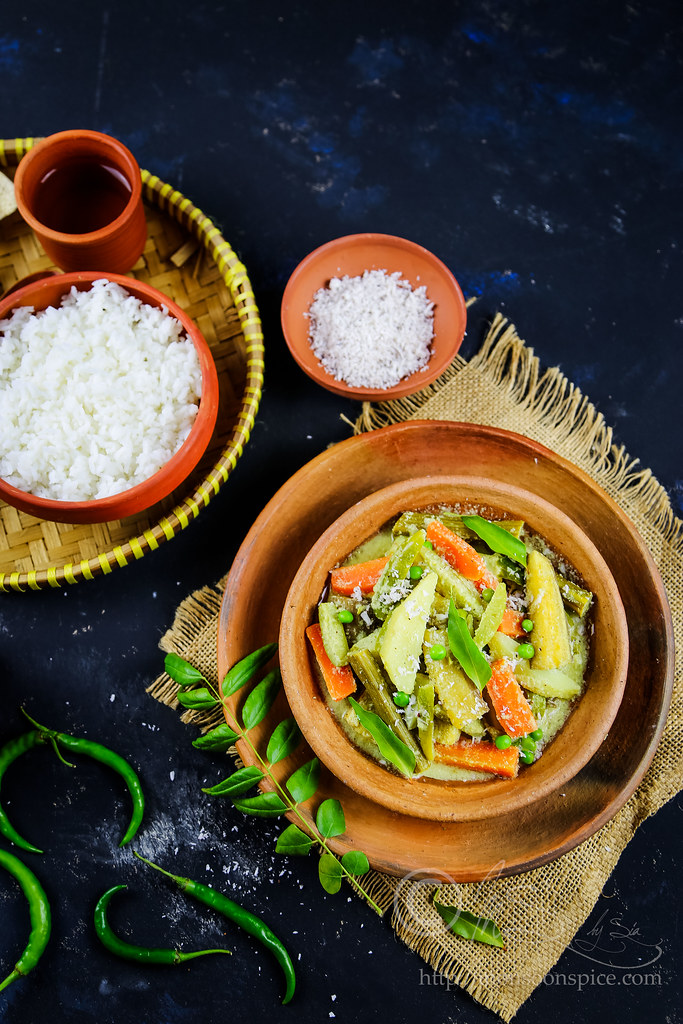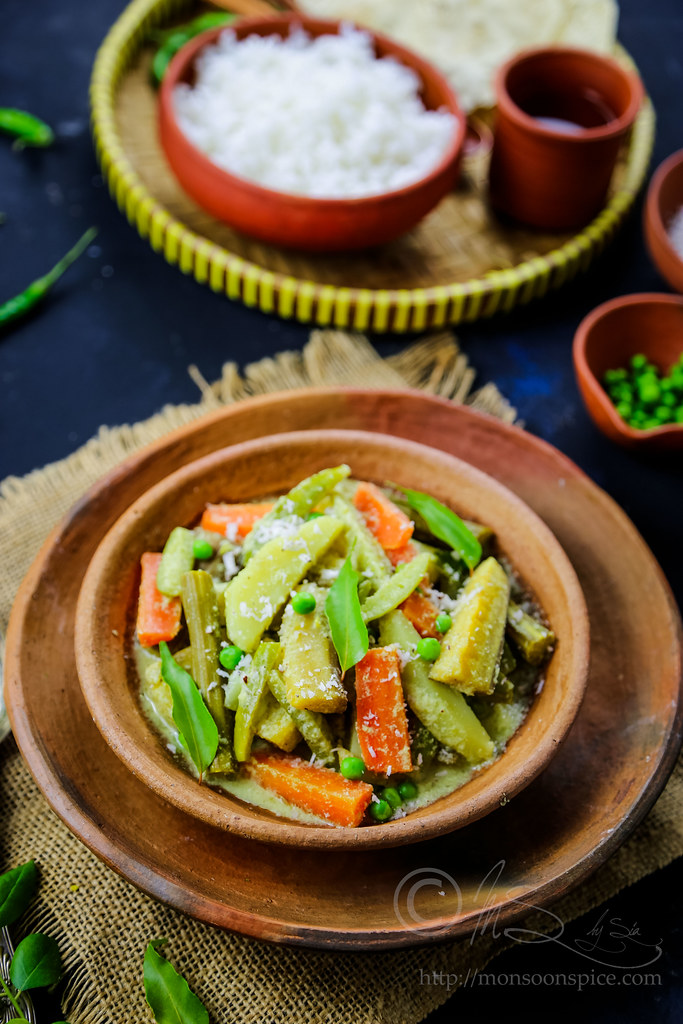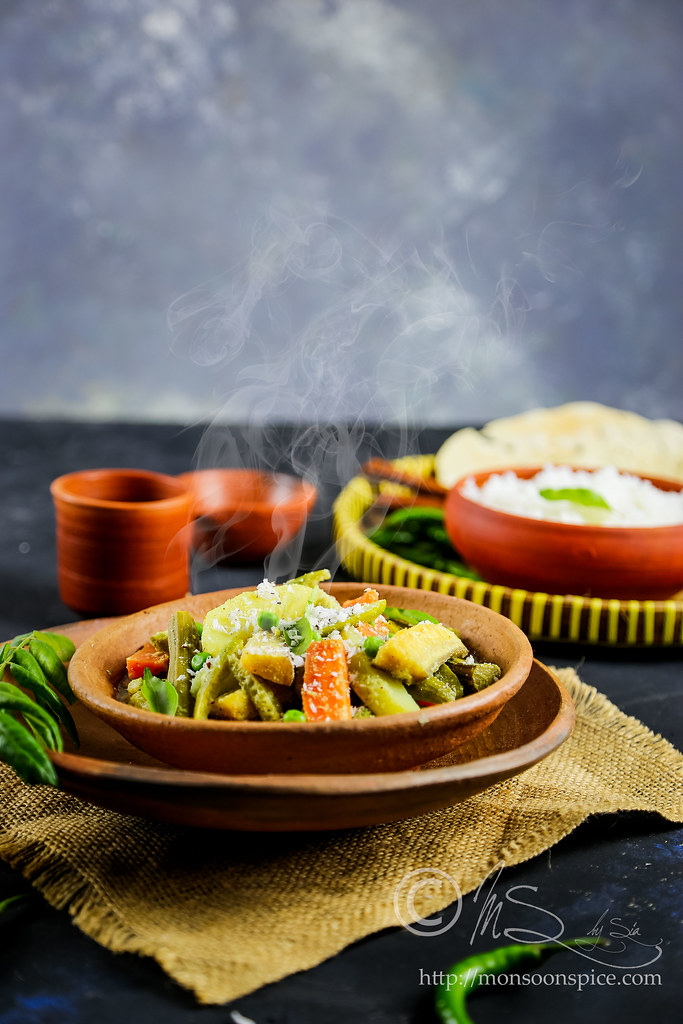
Learn how to make Aviyal or Avial ~ Keralan mixed vegetable medley with coconut and yogurt
Heaven must be a bit like Kerala, an ancient strip of lush, tropical land that slithers sensuously down the coast of south-western India.Blessed with tropical, balmy weather and plentiful rain, Kerala is truly God’s own country. The land of sparkling backwater zigzagging the lush green landscape dotted with paddy fields, tea plantations and the majestic coconut trees swaying to the cool breeze of Arabian sea, Kerala is home to world’s most precious treasure – spices that have lured traders from antiquity, and then the invaders many centuries ago. At the end of 15th century the Portuguese explorer Vasco Da Gama hitched up his sail and after circling the Cape of Good Hope landed in Kerala at the port of Calicut and soon the other Europeans – Dutch, French and English – followed his sea route. What started as a lucrative spice trade soon created a whirlwind of brutal violence and colonisation in the name of God, king and country leaving a trail of blood stained the map of India!
~ Madhur Jaffrey

Ingredients for Aviyal

Black pepper, the king of spices and the most coveted spice was believed to be worth its weight in gold is still one of the most loved spices in the present day is grown abundantly in Kerala along with many other spices like cinnamon, cloves, cardamoms etc. Keralan cuisine is loved for not just it’s balanced used of spices, but also inclusivity of local produce in everyday cooking. Sadya – a celebratory feast consisting of a variety of traditional vegetarian dishes usually served on banana leaves – showcases the beauty of Keralan vegetarian dishes cooked with a wide range of locally grown vegetables like gourds, green plantains, root vegetables, yams etc cooked with freshly grated coconut, coconut milk, yogurt, and lentils etc. Almost every savoury dish has two main ingredients – coconut oil and fresh curry leaves – and it is impossible to imagine Keralan cuisine without these two!
Growing in South Canara which shares its border with Kerala, our traditional recipes kind of overlaps with ones another with almost similar cooking ingredients and techniques. Our palya is very similar to Keralan thoran, our sasive is just like the Keralan pachadi, our melara or majjige huli is similar to morkari, our kottige is similar to ela ada and the list goes on and on! What I am trying to say is there are many versions of the same recipe which may be cooked with the same or different ingredients and spices from one house to another and from one region to another. Indian food is all about diversity and how every culture embraces this diversity lovingly making it their own in their unique way!
One more recipe that is lovingly cooked and enjoyed throughout the year is Avial or Avial – mixed vegetable medley with coconut and yogurt. While the Keralan Avial is somewhat a dry-wet curry, at home my Amma and Ajji always made a little gravy based Avial which was served with boiled red matta rice. The ivy gourd and drum sticks are the must vegetables and the aviyal is always finished with a tadka of mustard seeds and curry leaves in pure coconut oil extracted from homegrown kobbari or kopra (dried coconut) in local oil mill under the watchful eye of a family matriarch. Avial is one of the must-have dishes in every celebratory meal in my family and it is always served along with palya – dry vegetable stir-fries – just before serving saaru (lentil soup similar to rasam) in traditional baLe ele ooTa (banana leaf meal).


The recipe I am sharing today is the Keralan Avial or Aviyal which captures the spirit of this truly beautiful state. Creaminess from fresh coconut ground with cumin seeds and green chillies and a touch of tangy notes from yogurt, this mixed vegetable medley is a shining example of less is more! The generous drizzle of coconut oil and curry leaves is the finishing touch to this mild curry. For a state that produces the best spices in the world, it is humbling to see how thoughtfully they use their spices in cooking. The only spices used in Aviyal are a pinch of turmeric and little jeera or cumin seeds that lends its earthy flavour which compliments the sweetness of coconut, the heat of fresh green chillies and tanginess of yogurt.
Traditionally, ash gourd, drumstick, yellow cucumber, green plantains, yam, string beans etc are used but you can use vegetables like carrot, potato, zucchini, French beans, butternut squash or any vegetables of your choice to make Aviyal. The idea is to use as many vegetables as possible with different flavours and textures. I have used assorted vegetables that are easy to source in my neck of woods. But there are two main ingredients without whom this dish is incomplete – coconut oil and fresh curry leaves – which gives the Avial the authentic taste. Don’t be misguided by the simple ingredients and cooking technique as this dish is truly special! Aviyal is so special that it is offered to the presiding deity of Padmanabhaswami temple in Thiruvanantapuram and distributed as prasad to the devotees for centuries. After the dish was cooked in an earthen pot, my mother and grandmother would cover the pan with banana leaf and place the lid on top of it. The steam rising from the hot aviyal made the banana leaf sweat and added a beautiful aroma to the already flavourful curry! If you can source the banana leaf, I highly recommend you to give it a try. Now, without further ado, let’s get cooking Aviyal!


Avial or Aviyal (Keralan mixed vegetable medley with coconut and yogurt)
Prep Time: 10-15 mins
Cooking Time: 15-20 mins
Recipe Level: Easy/Beginner
Spice Level: Low
Serves: 5-7 people
Shelf Life: Best served fresh but can be refrigerated for 2-3 days
Serving Suggestion: With plain rice
Ingredients:
6-7 cups of mixed vegetables (I have used a drumstick, potato, green plantain, carrot, ivy gourds and green peas)
1 cup yogurt
¼ tsp haldi/turmeric powder
1-2 tbsp coconut oil
12-15 curry leaves
Salt to taste
For coconut paste:
1½ cups grated coconut (fresh or frozen)
1 tsp jeera/cumin seeds
2-4 green chillies (as per taste)


Method:
Preparation:
- First, prepare all the vegetables for the aviyal. Peel and cut the carrot, green plantain and potato into 3 inches long pieces. Place the green plantain and potato pieces in a bowl of cold water to prevent them from discolouring due to oxidation. Peel or scrape the drumsticks and cut it into 3 inch long pieces. Trim the ends of tindora or ivy gourd and slit it into long quarters.
- Make the coconut paste by grinding grated coconut, cumin seeds and green chillies into a thick, coarse paste by adding ½ cup water.
Proceed to cook:
- In a sauté pan, first take all the vegetables that take longer time to cook, in my case, drumstick, carrot and ivy gourd. Add turmeric powder and salt to taste. Add just enough water to cover the vegetables and mix them all well. Cover and cook on medium heat until they are half cooked, about 5-7 mins.
- Add rest of the vegetables and mix them well. Add little more water if required before covering the pan and cooking the vegetables until they are cooked through. It will take around 5-7 mins on medium heat.
- Reduce the heat to low and add the coconut paste. Gently mix them well to make sure you don’t break the vegetables. Bring the curry to a gentle boil on a low heat.
- Whisk and add the yogurt and mix everything well. Simmer the curry for 4-5 mins to prevent the yogurt from curdling.
- Turn off the heat and swirl in coconut oil and curry leaves. Cover and let it rest for at least 10-15 mins for the flavours to blend well. My mother and grandmother would cover the pan with banana leaf and place the lid on top of it! Serve Aviyal warm or cold with plain boiled rice and enjoy!
Sia’s Notes:
- Traditionally, ash gourd, drumstick, yellow cucumber, green plantains, yam, string beans etc are used but you can use vegetables like carrot, potato, zucchini, French beans, butternut squash or any vegetables of your choice to make Aviyal. The idea is to use as many vegetables as possible with different flavours and textures.
- After the dish was cooked in an earthen pot, my mother and grandmother would cover the pan with banana leaf and place the lid on top of it. The steam rising from the hot aviyal made the banana leaf sweat and added a beautiful aroma to the already flavourful curry! If you can source the banana leaf, I highly recommend you to give it a try.

No comments:
Post a Comment
Namaste! I am Sia and welcome to Monsoon Spice, my virtual home. Thank you for all your comments, inputs and feedback. I really appreciate the valuable time you spent browsing through my recipe repertoire.
I hope you have found what you are looking for today. Feel free to leave any questions or queries you have on the recipes posted here. If you have any recipe requests, please drop a line at Ask Sia page. I will try to respond to all your queries as soon as possible to best of my knowledge.
I welcome all your valuable inputs and constructive criticism as long as it is meant to help and improve the blog. I reserve the right to delete any comments that are rude, abusive, written with the intent to advertise, contain profanity or considered spam.
I hope that you will stop by again to read my rants, learn new recipes and share your ideas. Have a good look around and enjoy your time here. Thank you once again!